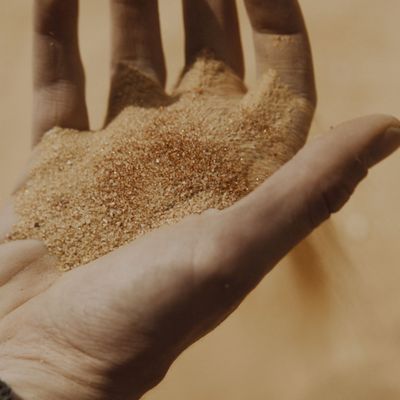
Many movies have been made about the terrifying, lusty power of the sea. The sea, Hollywood often suggests, is a net-bad, but in a sort of sensual way. If the sea shows up in a movie, you can be confident that someone will be grievously injured by it and/or have poorly considered sex in it. At best, the sea will drown a protagonist and put them out of their earthly misery, but more likely, it will erotically torment them, providing the stage upon which a suspiciously intelligent shark can flirt with Blake Lively’s mortality and old hubristic white men can barely survive a ton of preventable boat accidents and freakish underwater creatures can try to kill Kristen Stewart and Naomi Watts and Robin Wright can have sex with each other’s sons.
But I am not here today to talk about the sea, which has gotten enough attention as it is. I am here to suggest that while the sea has historically gotten more cinematic credit, there is an even scarier and sultrier natural element that has been quietly doing the villain work all along. It is the sea’s frenemy and eternal next-door neighbor, the Joan Crawford to its Bette Davis, the Ashley to its Mary-Kate. It is … sand. From Dune (1984) to Dune (2021), sand has long been just as sexy and freaky of an antagonist as the sea, albeit underappreciated.
Sand is fucked up. And unlike the sea, which is water, nobody can even agree on what sand is. (On the Wikipedia page for sand, under “composition”: “The exact definition of sand varies.” Excuse me … ???) I started thinking pretty hard about sand last week as I watched Dune (2021), which is a new Denis Villeneuve movie about how crazy dunes are if you really stop to ponder them. Unlike most people, I have always stopped and pondered dunes. When I was a kid, my grandpa, a kind of rude but good doctor (may he rest in peace), used to warn me about the dangers inherent in doing all sorts of everyday things: walking under an automatic garage door, lest its mechanism fail the moment I was beneath it, instantly decapitating me; eating sushi and getting a brain-eating parasite. The most upsetting thing he ever said to me, however, was that I should never play in sandboxes or any kind of sand-accumulation site, because the sand could, without warning, overpower and instantaneously suffocate me. Save for my dead grandfather and Dune and the Wikipedia page for sand, nobody is talking about this.
In Dune, Timothée Chalamet plays a young man who lives some millions of years in the future, on an entirely different planet than Earth, but who is nonetheless named Paul. I simply refuse to go any further here vis à vis the plot of Dune, which is so famously insane that it has destroyed the lives of people much more intelligent than I, but suffice to say that Paul spends a lot of the movie on a planet named Arrakis that is made up entirely of thick, hot sand. At least 90 percent of the movie is about how sand is absolutely wild, conceptually and in practice. There are at least three scenes wherein Oscar Isaac, playing Paul’s rich hot dad, stares at the sand and yells, “Desert power!” The oppressed and exploited native population of Arrakis live underneath the sand, having learned to adapt to its cruel madness over generations; when they’re outside on top of the sand, they wear special suits and breathe through special tubes and still sometimes get absolutely pummeled to death by sand. In an early scene, a very sand-adjusted woman (Sharon Duncan-Brewster) explains to Oscar Isaac and Paul that the planet’s sand is basically a death sentence for humans and machinery alike. If the sand doesn’t get them, the sandworms do, and if the sandworms don’t get them, the violent sandstorms do, and if the violent sandstorms don’t kill them, the sun being so hot on the sand will, and if the sun doesn’t do it, everyone just kills one another because they’re so mad about the sand.
There are a handful of films that get at this same idea, i.e., that sand sucks and we need to respect it or it will take back the Earth. I’m not talking about movies that deal with the desert as a natural setting (Lawrence of Arabia, et al.), or movies that usually focus on how the desert is sweltering and dry and full of hot people and occasionally extraterrestrials — I’m talking about movies that bitch specifically about sand as a concept.
My personal favorite movie about bad sand is Woman in the Dunes, a 1960s Japanese arthouse movie about a woman who lives at the bottom of a dune and who is condemned to dig pounds of sand out of her house all night every night for the rest of her natural life. The movie unfolds like a particularly bleak Twilight Zone episode: Early on, the dune woman ensnares a tourist so that she can have a sand-digging assistant, as well as someone to have sandy sex with (worst kind of sex, hands down). The two spend literally two and a half hours covered in and complaining about sand. “Sand ruins everything, doesn’t it?” moans her fellow dune-prisoner. “If it wanted to, sand could swallow up countries and even cities. You can’t fight it. It’s hopeless!”
Absolutely coated in layers of sticky, sharp sand 100 percent of the time, even while they sleep, the two spiral into madness, wondering if they can somehow turn their sandy hellscape into some kind of resort: “We have to use the sand for us, not against us!” The only possible method of escape is to climb up the mountain of sand that surrounds them, which, if you know sand, you know it crumbles as a single entity instantly upon contact. Woman in the Dunes is part-fable, part-nightmare, a sort of parable about the Sisyphean task of being alive under capitalism. The same trenchant point is made in Star Wars, Episode II: Attack of the Clones, which I shan’t rewatch ever but is, I think, a film about a group of clones that band together in some kind of warlike formation to attack their original incarnations (?). Anakin Skywalker finds time in his busy war schedule to complain about sand: “I don’t like sand. It’s coarse, and rough, and irritating, and it gets everywhere.” Natalie Portman’s character nods sympathetically. “So true, bestie,” she says.
In 2003’s Holes, a bunch of juvenile delinquents are forced to live out the worst possible punishment known to mankind: digging a bunch of holes in sand. The central horror of the film is that Stanley Yelnats (Shia LaBeouf) and his filthy cohorts have shoes full of sand at all times; they even sing a little song about this. Even the sight of Sigourney Weaver in a cowboy hat with her hands on her hips is not enough to assuage the pain of having sand in one’s shoes forever. The film’s denouement occurs when Stanley finds a place nearby the sand holes that has less sand. Incidentally, if you Google “Holes movie,” make sure you include a few other qualifiers in your search.
In Mad Max: Fury Road, not only is it the apocalypse, it is the sand apocalypse. Charlize Theron’s Furiosa is capable of fending off psychotic predators but is helpless in the face of the abounding brutal sandstorms that swallow people whole. Sandstorms similarly plague the world of The English Patient; Kristin Scott Thomas and Ralph Fiennes get trapped in the middle of the desert after a particularly bad one and only after a few flirty minutes do they realize that their friends are freaking buried alive beneath the sand. Sandstorms pop up again in The Mummy, a film wherein Brendan Fraser pulls out a machine gun and starts shooting at a wall of sand, as is the American way. Despite this brave effort, the only thing that defeats the wall of sand in The Mummy is when Rachel Weisz makes out with the guy who is making the sand act in an evil manner. That makes a lot of sense, to me. We could solve 90 percent of the world’s problems in this way.
I would be remiss to not include a brief aside about the most upsetting subgenre of sand, quicksand. In the 1990s, half of the world’s children, myself included, were brainwashed by a handful of films and TV shows —The Neverending Story and The Princess Bride, among others — into believing that at any moment, in any climate, we or our beloved pets could be sucked into the earth via spontaneously occurring quicksand. Quicksand could be anywhere: the forest, the sidewalk, under your bed, in your heart. It was important to be vigilant. When I grew up, I became convinced for no real reason that quicksand was fake, a concept pushed forward by the CIA à la abstract expressionism in order to keep children from becoming communists. But actually, I’ve since learned that it’s real and we should not take our horses anywhere near it.
Anyway. Trying to talk about sand for too long is like climbing up a pile of sand: impossible, dangerous. Why are we still here, discussing sand, when a sucking vortex of quicksand could appear in our apartments at any minute? We must accept that we will never truly understand sand. Or maybe we will. I’m not a scientist. Actually, we probably already understand it, and I just read Wikipedia. Either way, we must respect its elusiveness, its spontaneity, its ability to turn into a goopy mush or a wall or a conductor of extreme heat depending on its mood. Sand’s ability to kill us in like, 75 different ways makes it a cinematic supervillain on par with the cruel diva that is the sea. It’s time to recognize her and then run away from her, screaming.
More on Dune
- Dune: Prophecy Recap: The Sisterhood Is Doing It for Themselves
- Dune: Prophecy Recap: Ancient History
- Dune: Prophecy Recap: A Harkonnen Never Forgets


